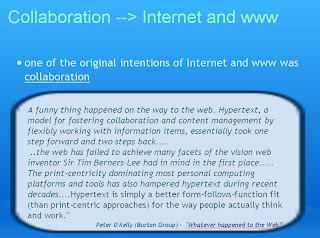From Burton Group Research Director Peter O’Kelly:
If you’re a Burton Group Collaboration and Content Strategies subscriber, you may also find a report I wrote in 2006 useful: Hypertext and Compound/Interactive Document Models: Collaboration and Content Management Implications. An excerpt from the synopsis of the Burton Group report:
A funny thing happened on the way to the web. Hypertext, a model for fostering collaboration and content management by flexibly working with information items, essentially took one step forward and two steps back. Hypertext Markup Language (HTML), introduced with the World Wide Web, has become the global standard for hypertext content. But, ironically, it’s actually rather basic and limited. As a result, the web has failed to achieve many facets of the vision web inventor Sir Tim Berners-Lee had in mind in the first place.
The print-centricity dominating most personal computing platforms and tools has also hampered hypertext during recent decades. Although Vannevar Bush eloquently articulated his vision for a much more effective way of working with and collaborating through content more than 60 years ago, today’s most widely deployed platforms and tools are still dominated by conceptual models based on a foundation of digitized file cabinets and traditional documents.
This is all about to change, as the rapid growth of blogs, wikis, and other market dynamics are helping information workers to more fully exploit the advantages of beyond-the-basics hypertext along with compound and interactive document models. Although the trends are also accompanied with the usual assortment of market hype and new buzzwords, they may well, collectively, usher in a renaissance in collaboration and content management.
Hypertext is simply a better form-follows-function fit (than print-centric approaches) for the way people actually think and work. Compound documents facilitate focusing more on information work than on disparate technologies and tools, and foster more effective content management. Interactive document models are used to automatically and unobtrusively offer supplemental resources and actions in context, providing opportunities to more effectively leverage tools and metadata without disruptive context shifts.






No comments:
Post a Comment